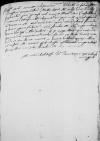List #654
Ioannes DANTISCUS do Sigmund von HERBERSTEINBrussels, 1531-07-20
Rękopiśmienne podstawy źródłowe:
Publikacje:
| ||||||
Tekst + aparat krytyczny + komentarzZwykły tekstTekst + komentarzTekst + aparat krytyczny
Magnifico domino
Magnifice Domine, amice observandissime. Salutem et felicissimorum successuum augmentum.
Mitto iterum Magnificentiae Vestrae hunc litterarum fasciculum, quem, quaeso, ad manus
Dat(ae) or Dat(um)⌈Dat(ae)Dat(ae) or Dat(um)⌉
Magnificentiae Vestrae deditissimus
[1] The fascicule, sent this time from Brussels to Cracow, probably contained a diplomatic report addressed to Sigismund I and carrying the same date as the mentioned letter to Herberstein (see AT, XIII, No. 241, p. 224-228), as well as Dantiscus’ letter to chancellor Krzysztof Szydłowiecki (copy, GStAPK, HBA H, K. 759, V.11.6, f. 9r-12v). Herberstein received those letters on August 11 on the border of Styria, and immediately sent them through the Viennese postmaster on to Cracow (see letter No. 19, footnote !!!), where they arrived on August 17, 1531 at the latest (see AT, XIII, No. 283, p. 261).
[2] A reference to the call to the Reich diet, expected at the court of Charles V in Brussels; the place and time was to be specified by king of the Romans Ferdinand I (see AT, XIII, No. 194, p.190).The emperor’s departure in August was delayed, among other things by sickness and negotiations with Francis I. Though the diet was to gather in Speyer in the second half of 1531, it ultimately began in April 1532 in Regensburg (see Sutter-Fichtner, p. 96-97; AT, XIII, No. 368, p. 339; cf. letter No. 20, footnote 2).
[3] The mention of alleged unrest in Scotland most likely refers to the events of 1526-28, when the mother of James V – Margaret Tudor, who was the regent in his name – divorced the Earl of Angus, which led his relatives – the Douglas clan – to kidnap and hold James V captive at the FalklandPalace. He managed to escape in 1528, to rule by himself. He ruthlessly repressed the nobles (whose role had grown excessively during the regency), and in terms of religious policy fought against new trends. Dantiscus passed on similarly laconic information about Scotland to Sigismund I (see footnote 3).


 OSK, Fol Lat. 258, f. 230v
OSK, Fol Lat. 258, f. 230v